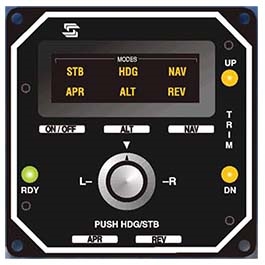
The new Garmin GI-106B CDI that I installed along with the GTN 650 still has some very important functions. The GPS knows exactly what heading changes need to be made and when to make them in order to guide the aircraft around a procedure turn and intercept the final approach course. This is exactly what is happening except that the very skilled pilot happens to be the GPS receiver. Just imagine that a very skilled pilot is operating the HGD bug on the DG and the pilot knows exactly when and how much heading change to make in order to turn smoothly on the next route segment or intercept that route segment if off course. The autopilot has no idea that he is being driven buy the GPS while in GPSS mode.

As far as the autopilot is concerned he is just getting heading commands from a HDG bug on the directional gyro. In order to implement this the GPSS module has a switch to change from HDG mode to GPSS mode. When in NAV mode the autopilot responds to the CDI for lateral guidance (and the CDI glide slope if the autopilot has that capability like my 60-2 does.) When in HDG mode the autopilot would normally respond to the Heading Bug on the Directional Gyro but if GPSS is installed the autopilot actually has two separate functions while in HDG mode: 1) Follow the HDG bug on the DG 2) Follow the GPS Roll Steering commands that are provided by the GPS via ARINC 429 output that is routed to the autopilot GPSS module and converted into Heading Commands as if the HDG bug were providing them. First we need to understand that after installing GPSS the autopilot has two completely different interfaces. As I did this installation myself I am quite familiar with the wiring involved which helps in understanding how the autopilot responds so differently to GPSS (GPS Roll Steering) than it does to the CDI (Course Deviation Indicator). As I recently installed a Garmin GTN 650 and add S-TEC GPSS to my 35 year old S-TEC 60-2 autopilot I thought I might respond also. That got me thinking that the Aspen GPSS still needed to have its gain adjusted.Pugz provided some very good information back on September 29th. In fact, I believe it flew the turns more precisely than the Aspen GPSS and didn't hunt for the wind correction, in fact, it seemed to turn perfectly to the correct wind correction angle. I just turned on the S-Tec GPSS and selected HDG/ALT on the autopilot, then flew it as an LNAV and it worked great. Anyhow, my instructor wanted me to fly an RNAV approach with the Aspen failed, the TUP RNAV 18, an LPV. In fact, you'd recommended keeping the S-Tec GPSS for a different reason than redundancy, because it was "tuned" for the autopilot. The Aspen's GPSS is primary, but if I turn it off, I can use the S-Tec GPSS. So, I had the avionics shop retain my original S-Tec GPSS. That is just when you'd really like to have an autopilot. As you may recall, I fretted about loss of the use of my autopilot in the event of an Aspen failure. We "failed" the Aspen by turning it off within a menu to bypass the battery backup. What got me interested in adjusting the Aspen GPSS gain was a training flight with my instructor Saturday. The problem is that you have to change the setting on the ground, then go fly an approach, then land and change it again, and I haven't made time to fly several approaches to fine tune it. In an email to Aspen recently, it sounded like they were now recommending a setting of 1.5-2.0 for S-Tec autopilots, so I turned it up to 1.75 today to see what that does, but haven't flown yet. It's probably OK with approaches, but haven't had to do any lately. I turned the GPSS gain down to 1.5 a few months ago, and it was fine in cruise, no longer hunting too much in a crosswind. I don't recall doing approaches to see how the higher gain performed as the hunting in cruise was annoying, kind of like a mild form of using a VOR and a NAV setting on the autopilot in the old days. When it became adjustable last summer, I bumped it up to 2 per their initial recommendations for S-Tec autopilots (1.5 for any other autopilots), but then it hunted in cruise with a crosswind (perhaps too much gain rather than too little).

1.0 was the original factory default, and Aspen's tech rep last year told me they had complaints of slow turning and overshoots during approach with a setting of 1 with S-Tec autopilots.
#Stec 50 autopilot with gpss trial#
I have been using trial and error, but GPSS gain is only adjustable on the ground in a maintenance mode, making it difficult. I am posting here to see if anyone here has direct experience with working to find the best Aspen GPSS gain setting for the S-Tec autopilots, mine being a 60-2.


 0 kommentar(er)
0 kommentar(er)
